light Citroen C4 PICASSO 2016 2.G Manual PDF
[x] Cancel search | Manufacturer: CITROEN, Model Year: 2016, Model line: C4 PICASSO, Model: Citroen C4 PICASSO 2016 2.GPages: 527, PDF Size: 13.72 MB
Page 309 of 527
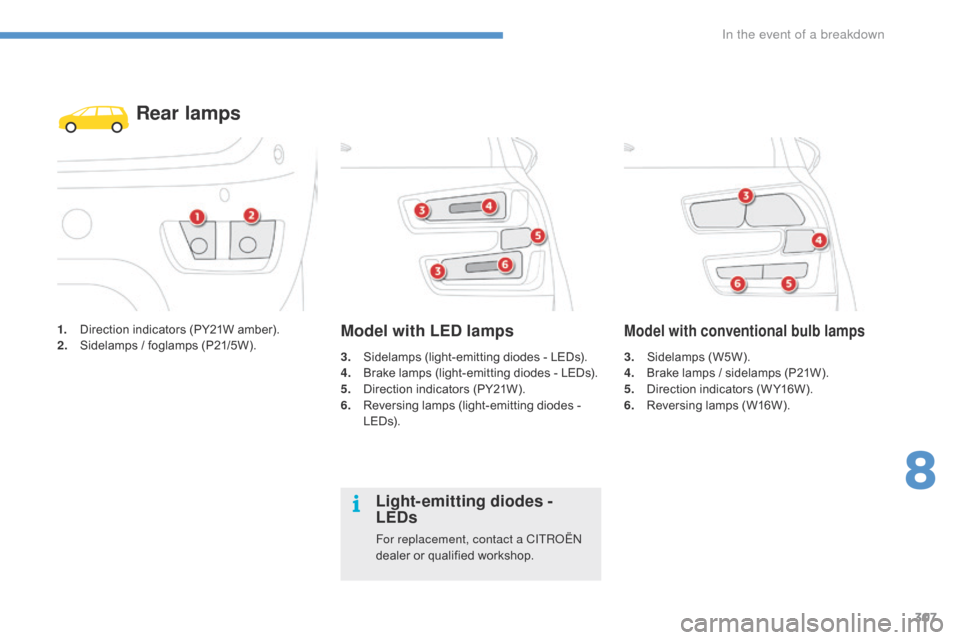
307
C4-Picasso-II_en_Chap08_en-cas-panne_ed01-2016
1. Direction indicators (PY21W amber).
2. S idelamps / foglamps (P21/5W).
Rear lamps
3. Sidelamps (light-emitting diodes - LEDs).
4. B rake lamps (light-emitting diodes - LEDs).
5.
D
irection indicators (PY21W).
6.
R
eversing lamps (light-emitting diodes -
L
ED s).
Model with LED lamps
3. Sidelamps ( W5W).
4. B rake lamps / sidelamps (P21W).
5.
D
irection indicators (W Y16W).
6.
R
eversing lamps (W16W).
Model with conventional bulb lamps
Light-emitting diodes -
LEDs
For replacement, contact a CITROËN
dealer or qualified workshop.
8
In the event of a breakdown
Page 311 of 527

309
C4-Picasso-II_en_Chap08_en-cas-panne_ed01-2016
Direction indicator, sidelamp and
foglamp
Access is by passing a hand under the bumper.
F T urn the bulb holder a quarter of a turn and
pull
it out.
F
C
hange the bulb.
For reassembly carry out these operations in
reverse
o
rder.
You can also contact a CITROËN dealer or a
qualified
workshop for the replacement of these
b
ulbs. For the replacement of this type of lamp,
contact a CITROËN dealer or a qualified
workshop.
Third brake lamp (light emitting
diodes-LED)
Number plate lamps (W5W)
To refit, press on the lens to clip it in place.
F
I
nsert a thin screwdriver into one of the cut-
outs in the lens.
F
P
ush it outwards to unclip it.
F
R
emove the lens.
F
C
hange the faulty bulb.
8
In the event of a breakdown
Page 315 of 527

313
C4-Picasso-II_en_Chap08_en-cas-panne_ed01-2016
Fusebox 2Fuse N° Rating Functions
F7 10 ABoot
12 V socket, rear multimedia.
F8 20 ARear
wiper.
F10 30 ALocks.
F17 5 AInstrument
panel.
F18 5 AAutomatic
gearbox gear selector.
F21 3 ASTART/STOP
button.
F22 3 ARain
and sunshine sensor, windscreen camera.
F24 5 AParking
sensors, panoramic visual aid.
F27 5 AAutomatic
gearbox.
F29 20 AAudio
and telematic systems.
F32 15 A12
V sockets.
F35 5 AHeadlamp
beam height adjustment, heated rear screen, radar.
F36 5 AInterior
lighting: glove box, central storage, reading lamps,
c
ourtesy lamps.
8
In the event of a breakdown
Page 318 of 527
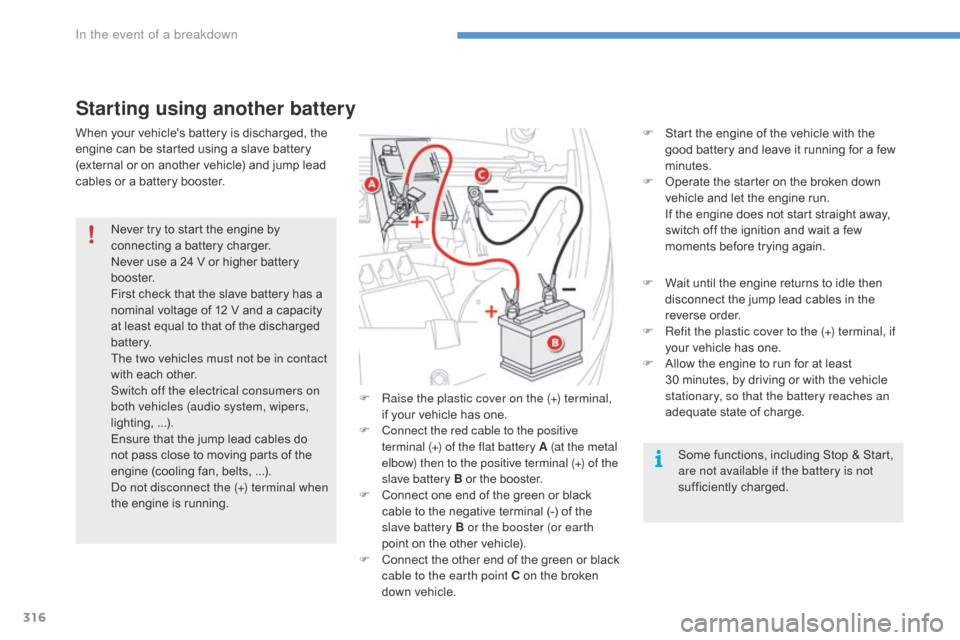
316
C4-Picasso-II_en_Chap08_en-cas-panne_ed01-2016
F Start the engine of the vehicle with the g
ood battery and leave it running for a few
m
inutes.
F
O
perate the starter on the broken down
v
ehicle and let the engine run.
I
f the engine does not start straight away,
s
witch off the ignition and wait a few
m
oments before trying again.
F
W
ait until the engine returns to idle then
d
isconnect the jump lead cables in the
r
everse
o
rder.
F
R
efit the plastic cover to the (+) terminal, if
your
vehicle has one.
F
A
llow the engine to run for at least
3
0 minutes, by driving or with the vehicle
s
tationary, so that the battery reaches an
adequate
state of charge.
Starting using another battery
Some functions, including Stop & Start, are not available if the battery is not
sufficiently
c
harged.
F
R
aise the plastic cover on the (+) terminal,
if
your
vehicle
has
one.
F
C
onnect the red cable to the positive
terminal (+) of the flat battery A (at the metal
elbow) then to the positive terminal
(+) of the
slave battery B
or
the
booster.
F
C
onnect
one
end
of
the
green
or
black
c
able
to
the
negative
terminal
(-)
of
the
s
lave battery B or the booster (or earth
point
on
the
other
vehicle).
F
C
onnect
t
he
o
ther
e
nd
o
f
t
he
g
reen
o
r
b
lack
c
able to the earth point C
on
the
broken
d
own
vehicle.
Never
try
to
start
the
engine
by
c
onnecting
a
battery
charger.
Never
use
a
24
V
or
higher
battery
b
o o s t e r.
First
check
that
the
slave
battery
has
a
n
ominal
voltage
of
12
V
and
a
capacity
a
t
least
equal
to
that
of
the
discharged
b
attery.
The two vehicles must not be in contact
with
each
other.
Switch off the electrical consumers on
both vehicles (audio system, wipers,
lighting, ...).
Ensure
that
the
jump
lead
cables
do
n
ot
pass
close
to
moving
parts
of
the
e
ngine
(cooling
fan,
belts, ...).
Do not disconnect the (+) terminal when
the
engine
is
running.
When
your
vehicle's
battery
is
discharged,
the
e
ngine
can
be
started
using
a
slave
battery
(
external
or
on
another
vehicle)
and
jump
lead
c
ables
or
a
battery
booster.
In the event of a breakdown
Page 319 of 527

317
C4-Picasso-II_en_Chap08_en-cas-panne_ed01-2016
Never try to charge a frozen battery.
I f the battery has been frozen, have
it
checked by a CITROËN dealer or a
q
ualified workshop, who will check that
t
he internal components have not been
damaged
and the casing is not cracked,
w
hich could cause a leak of toxic and
c
orrosive acid.
F
S
witch
off
the
ignition.
F
S
witch off all electrical consumers (audio
system,
lighting,
wipers, ...).
F
S
witch
off
the
charger
B
before
connecting
t
he cables to the battery, so as to avoid any
dangerous
spar
ks.
F
E
nsure
that
the
charger
cables
are
in
good
c
ondition.
F
R
aise the plastic cover, if your vehicle has
one,
on
the
(+)
terminal.
F
C
onnect
the
charger
B
cables
as
follows:
-
t
he positive (+) red cable to the (+) terminal
of the battery A ,
-
t
he
negative
(-)
black
cable
to
the
earth
p
oint C
on
the
vehicle.
F
A
t
the
end
of
the
charging
operation,
switch
o
ff
the
charger
B
before
disconnecting
the
c
ables from the battery A .
It is not necessary to disconnect the
battery.
If
you
envisage
charging
your
vehicle's
b
attery
yourself,
use
only
a
charger
c
ompatible with lead-acid batteries of a
nominal
voltage
of
12
V. Follow the instructions for use provided
by
the
manufacturer
of
the
charger.
Never
reverse
polarities.
Charging the battery using a battery charger
If this label is present, it is essential
to
use only a 12 V charger, to avoid
c
ausing irreversible damage to the
el
ectrical components related to the
Stop
& Start system.
For optimum service life of the battery, it is
essential to maintain an adequate state of
charge.
In some circumstances it may be necessary to
charge
the battery:
-
i
f you use your vehicle essentially for short
journeys,
-
i
f
the vehicle is to be taken off the road for
s
everal weeks.
Contact a CITROËN dealer or a qualified
workshop.
8
In the event of a breakdown
Page 320 of 527

318
C4-Picasso-II_en_Chap08_en-cas-panne_ed01-2016
The Stop & Start system may not be
operational during the trip following the
f
irst engine start.
In this case, the system will only be
available
again after a continuous
p
eriod of immobilisation of the vehicle,
a period which depends on the ambient
temperature
and the state of charge of
t
he battery (up to about 8 hours).
Do
not
force
the
lever
as
locking
will
n
ot be possible if the clamp is not
positioned
correctly;
start
the
procedure
ag
ain.
Disconnecting the (+) terminal
F
Ra
ise the lever A fully to release the
clamp
B
.
Reconnecting the (+) terminal
F
P
osition the open clamp B of the cable on
the
positive
post
(+)
of
the
battery.
F
P
ress down on the clamp to position it
correctly
on
the
battery
post.
F
L
ock
the
clamp
by
lowering
the
lever
A .
Disconnecting the battery
In order to maintain an adequate state
of
charge for starting the engine, it is
r
ecommended that the battery be disconnected
if
the vehicle is taken out of service for a long
p
eriod.
Before
disconnecting the battery:
F
c
lose all openings (doors, boot, windows,
r
oof),
F
s
witch off all electrical consumers (audio
system,
wipers, lighting, ...),
F
s
witch off the ignition and wait for four
m
inutes.
At
the battery, detach just the (+) terminal.Following reconnection of the battery
Following reconnection of the battery, switch on the ignition and wait 1 minute before starting to
p
ermit initialisation of the electronic systems.
H
owever, if problems remain following this
o
peration, contact a CITROËN dealer or a
qualified
w
orkshop.
Referring
to the corresponding section, you
m
ust
y
ourself
r
einitialise
(
depending
o
n
ve
rsion):
-
t
he remote control key,
-
t
he electric blind(s),
-
...
Quick release terminal
In the event of a breakdown
Page 326 of 527
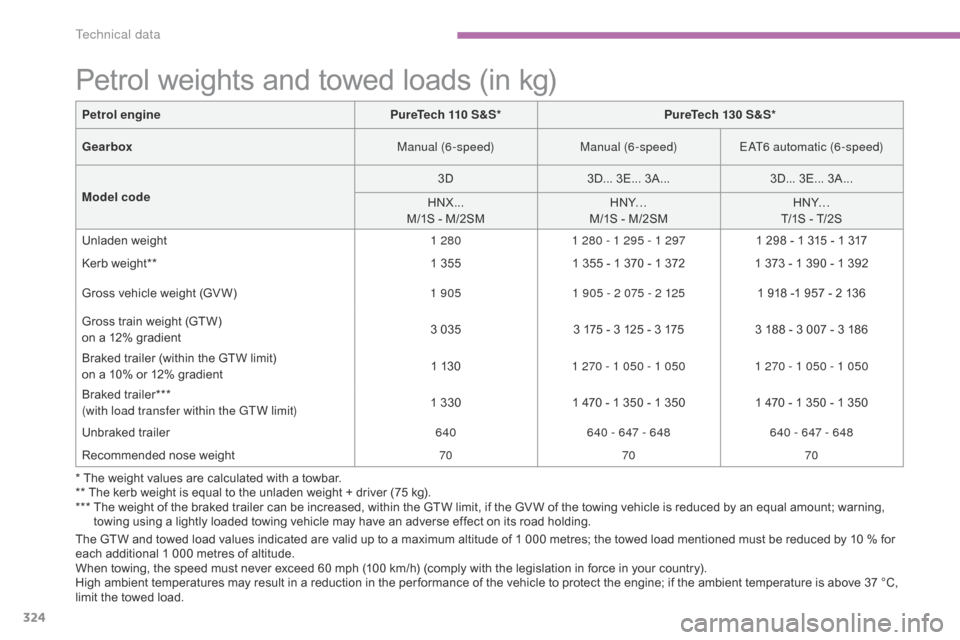
324
C4-Picasso-II_en_Chap09_caracteristiques-techniques_ed01-2016
* The weight values are calculated with a towbar.
* * The kerb weight is equal to the unladen weight + driver (75 kg).
***
T
he weight of the braked trailer can be increased, within the GTW limit, if the GV W of the towing vehicle is reduced by an equal amount; warning,
t
owing using a lightly loaded towing vehicle may have an adverse effect on its road holding.
Petrol engine
PureTech 110 S&S*PureTech 130 S&S*
Gearbox Manual (6-speed)Manual (6-speed)EAT6 automatic (6-speed)
Model code 3D
3D...
3
E...
3
A...
3D...
3
E...
3
A...
HNX...
M/1S - M/2SM
HNY…
M/1S - M/2SM
HNY…
T/1S - T/2S
Unladen weight
1 2801 280 - 1 295 - 1 297 1 298 - 1 315 - 1 317
Kerb weight**
1 355
1 355 - 1 370 - 1 372
1 373 - 1 390 - 1 392
Gross vehicle weight (GV W)
1 9051 905 - 2 075 - 2 125 1 918 -1 957 - 2 136
Gross train weight (GTW)
o
n a 12% gradient
3 035
3 175 - 3 125 - 3 175
3 188 - 3 007 - 3 186
Braked trailer (within the GTW limit)
o
n a 10% or 12% gradient
1 130
1 270 - 1 050 - 1 050 1 270 - 1 050 - 1 050
Braked trailer***
(with load transfer within the GTW limit) 1 330
1 470 - 1 350 - 1 350
1 470 - 1 350 - 1 350
Unbraked
t
railer
640640 - 647 - 648 640 - 647 - 648
Recommended nose weight
707070
Petrol weights and towed loads (in kg)
The GTW and towed load values indicated are valid up to a maximum altitude of 1 000 metres; the towed load mentioned must be reduced by 10 % for e
ach additional 1 000 metres of altitude.
When
towing, the speed must never exceed 60 mph (100 km/h) (comply with the legislation in force in your country).
High
ambient temperatures may result in a reduction in the per formance of the vehicle to protect the engine; if the ambient temperature is above 37 °C,
l
imit the towed load.
Technical data
Page 327 of 527
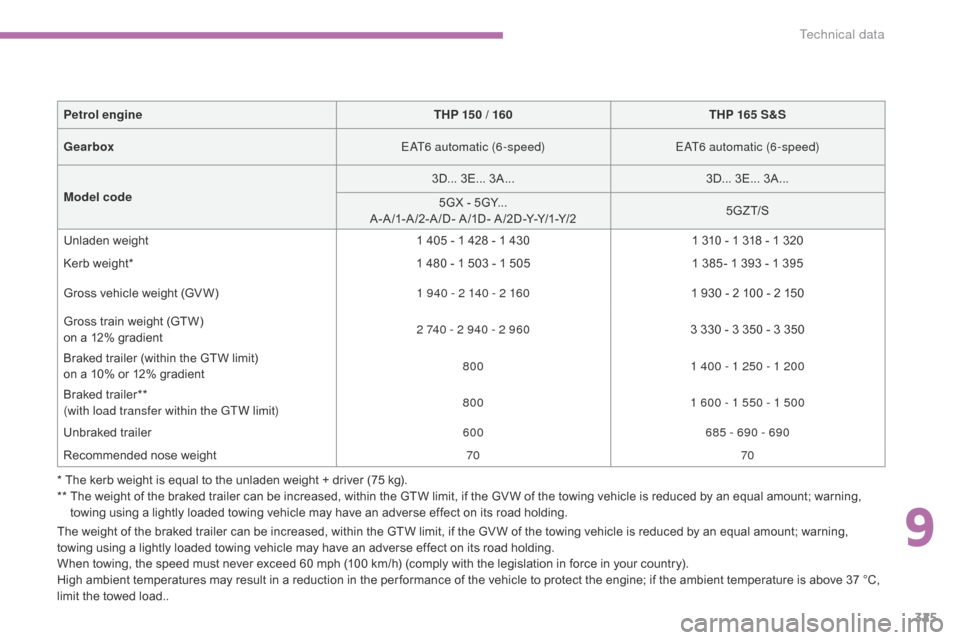
325
C4-Picasso-II_en_Chap09_caracteristiques-techniques_ed01-2016
The weight of the braked trailer can be increased, within the GTW limit, if the GV W of the towing vehicle is reduced by an equal amount; warning, towing using a lightly loaded towing vehicle may have an adverse effect on its road holding.
When
towing, the speed must never exceed 60 mph (100 km/h) (comply with the legislation in force in your country).
High
ambient temperatures may result in a reduction in the per formance of the vehicle to protect the engine; if the ambient temperature is above 37 °C,
l
imit the towed load..
Petrol engine
THP 150 / 160THP 165 S&S
Gearbox EAT6 automatic (6-speed)EAT6 automatic (6-speed)
Model code 3D...
3
E...
3
A...
3D...
3
E...
3
A...
5GX - 5GY...
A-A/1-A/2-A/D-
A/
1D-
A/
2D-Y-Y/1-Y/2
5G Z T/S
Unladen weight
1 405 - 1 428 - 1 430
1 310 - 1 318 - 1 320
Kerb weight*
1 480 - 1 503 - 1 505
1 385 - 1 393 - 1 395
Gross vehicle weight (GV W)
1 940 - 2 140 - 2 160 1 930 - 2 100 - 2 150
Gross train weight (GTW)
o
n a 12% gradient
2 740 - 2 940 - 2 960
3 330 - 3 350 - 3 350
Braked trailer (within the GTW limit)
o
n a 10% or 12% gradient
800
1 400 - 1 250 - 1 200
Braked trailer**
(with load transfer within the GTW limit) 800
1 600 - 1 550 - 1 500
Unbraked
t
railer
600685 - 690 - 690
Recommended nose weight
7070
* The kerb weight is equal to the unladen weight + driver (75 kg).
**
T
he weight of the braked trailer can be increased, within the GTW limit, if the GV W of the towing vehicle is reduced by an equal amount; warning,
t
owing using a lightly loaded towing vehicle may have an adverse effect on its road holding.
9
Technical data
Page 330 of 527

328
C4-Picasso-II_en_Chap09_caracteristiques-techniques_ed01-2016
Diesel weights and towed loads (in kg)
The GTW and towed load values indicated are valid up to a maximum altitude of 1 000 metres; the towed load mentioned must be reduced by 10 % for each additional 1 000 metres of altitude.
When
towing, the speed must never exceed 60 mph (100 km/h) (comply with the legislation in force in your country).
High
ambient temperatures may result in a reduction in the per formance of the vehicle to protect the engine; if the ambient temperature is above 37 °C,
l
imit the towed load.
Diesel engine
HDi 115BlueHDi 100 S&S*
Gearbox Manual (6-speed)Manual (6-speed)
Model code 3D...
3
E...
3
A...
3D...
3
E...
3
A...
3D...
3
E...
3
A...
9HC8 9HC8/1 BHY...
6/1S - 6/2SM
Unladen weight
1290 - 1 310 - 1 312
1 298 - 1 318 - 1 320
1 296 - 1 318 - 1 320
Kerb weight**
1 365 - 1 385 - 1 387
1 373 - 1 393 - 1 395
1 371 - 1 393 - 1 395
Gross vehicle weight (GV W)
1 940 - 2 110 - 2 1501 940 - 2 110 - 2 1501 950 - 2 120 - 2 175
Gross train weight (GTW)
on a 12% gradient
3 340 - 3 350 - 3 350
2 740 - 2 910 - 2 950 3 150 - 3 120 - 3 175
Braked trailer (within the GTW limit)
on a 10% or 12% gradient
1 400 - 1240 - 1 200
8001 200 - 1 000 - 1 000
Brakes trailer***
(with load transfer within the GTW limit) 1 600 - 1 540 - 1 500
8001 400 - 1 300 - 1 300
Unbraked
t
railer
680 - 690 - 690685 - 695 - 695645 - 659 - 660
Recommended nose weight
707070
* The weights are calculated with a towbar fitted.
** The kerb weight is equal to the unladen weight + driver (75 kg).
***
T
he weight of the braked trailer can be increased, within the GTW limit, if the GV W of the towing vehicle is reduced by an equal amount; warning, t
owing using a lightly loaded towing vehicle may have an adverse effect on its road holding.
Technical data
Page 331 of 527
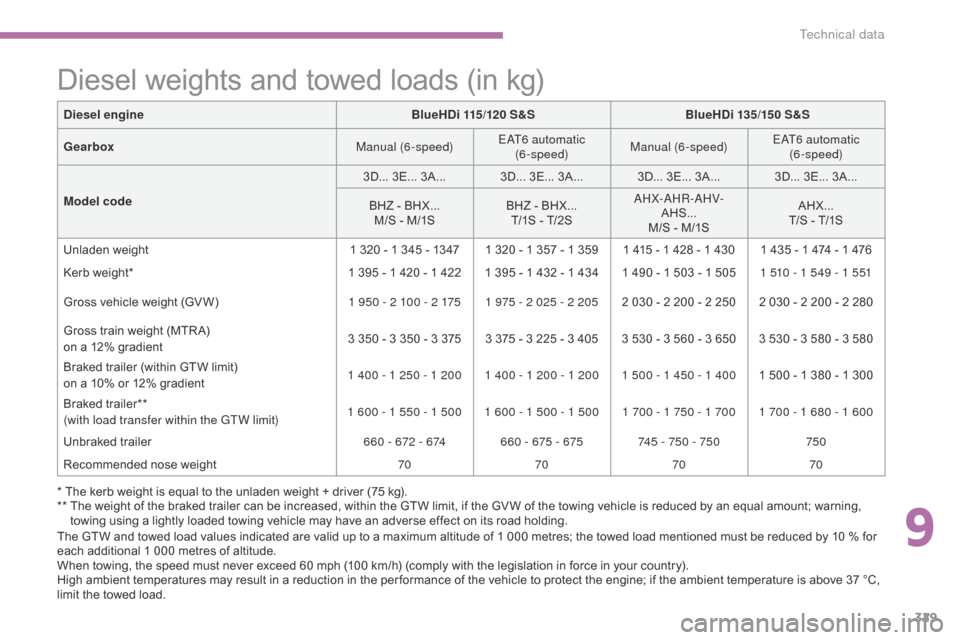
329
C4-Picasso-II_en_Chap09_caracteristiques-techniques_ed01-2016
Diesel weights and towed loads (in kg)
* The kerb weight is equal to the unladen weight + driver (75 kg).
* * T he weight of the braked trailer can be increased, within the GTW limit, if the GV W of the towing vehicle is reduced by an equal amount; warning,
t
owing using a lightly loaded towing vehicle may have an adverse effect on its road holding.
The
GTW and towed load values indicated are valid up to a maximum altitude of 1 000 metres; the towed load mentioned must be reduced by 10 % for
e
ach additional 1 000 metres of altitude.
When
towing, the speed must never exceed 60 mph (100 km/h) (comply with the legislation in force in your country).
High
ambient temperatures may result in a reduction in the per formance of the vehicle to protect the engine; if the ambient temperature is above 37 °C,
l
imit the towed load.
Diesel engine
BlueHDi 115/120 S&SBlueHDi 135/150 S&S
Gearbox Manual (6-speed)EAT6 automatic
(6-speed) Manual (6-speed) EAT6 automatic
(6-speed)
Model code 3D...
3
E...
3
A... 3D...
3
E...
3
A... 3D...
3
E...
3
A... 3D...
3
E...
3
A...
BHZ - BHX...
M/S - M/1S
BHZ - BHX...
T/1S - T/2S
AHX-AHR-AHV-
AHS...
M/S - M/1S
AHX...
T/S - T/1S
Unladen weight
1 320 - 1 345 - 1347 1 320 - 1 357 - 1 359 1 415 - 1 428 - 1 430 1 435 - 1 474 - 1 476
Kerb weight*
1 395 - 1 420 - 1 422 1 395 - 1 432 - 1 434 1 490 - 1 503 - 1 505
1 510 - 1 549 - 1 551
Gross vehicle weight (GV W)
1 950 - 2 100 - 2 175 1 975 - 2 025 - 2 205 2 030 - 2 200 - 2 250 2 030 - 2 200 - 2 280
Gross train weight (MTR A)
o
n a 12% gradient
3 350 - 3 350 - 3 375 3 375 - 3 225 - 3 405 3 530 - 3 560 - 3 650 3 530 - 3 580 - 3 580
Braked trailer (within GTW limit)
on a 10% or 12% gradient
1 400 - 1 250 - 1 200 1 400 - 1 200 - 1 200 1 500 - 1 450 - 1 400
1 500 - 1 380 - 1 300
Braked trailer**
(with load transfer within the GTW limit) 1 600 - 1 550 - 1 500 1 600 - 1 500 - 1 500 1 700 - 1 750 - 1 700 1 700 - 1 680 - 1 600
Unbraked
t
railer
660 - 672 - 674 660 - 675 - 675 745 - 750 - 750 750
Recommended nose weight
70707070
9
Technical data